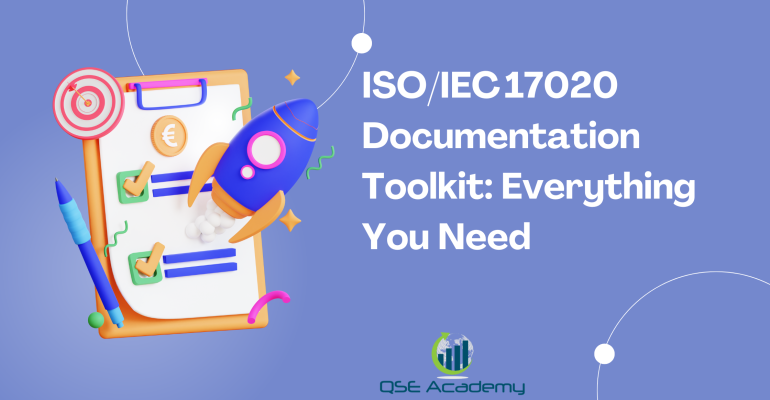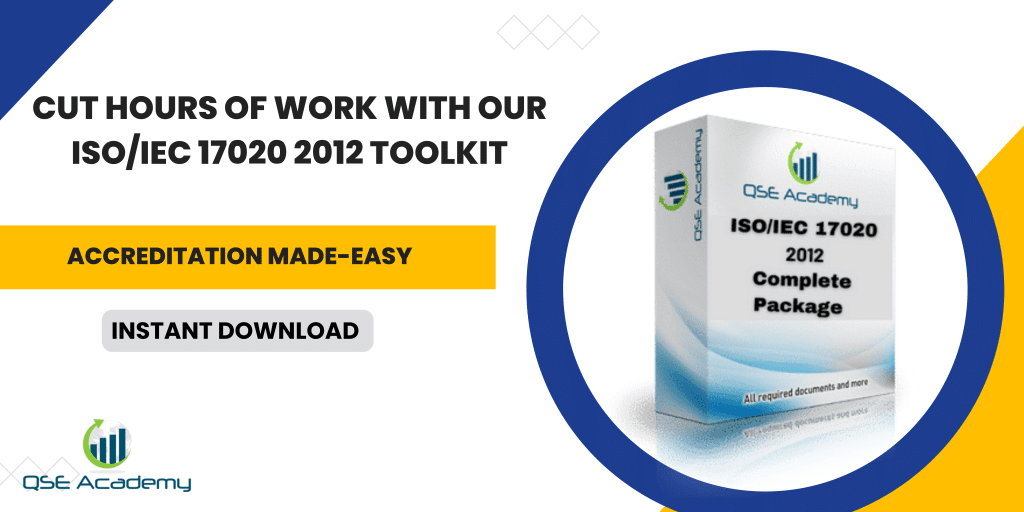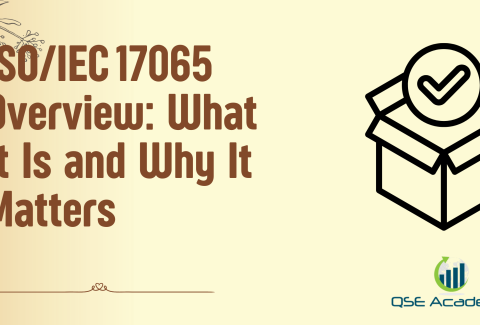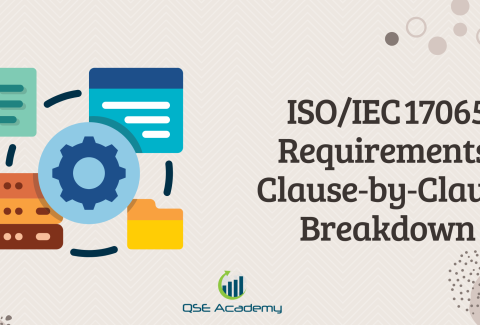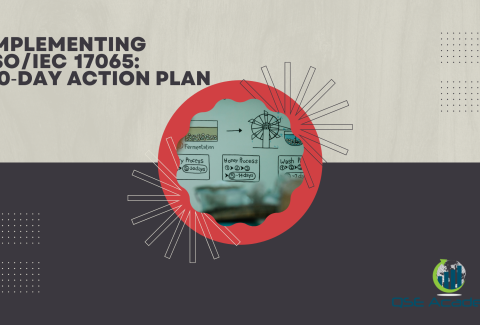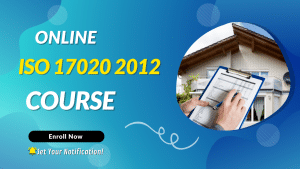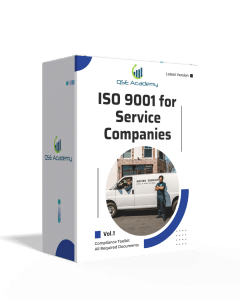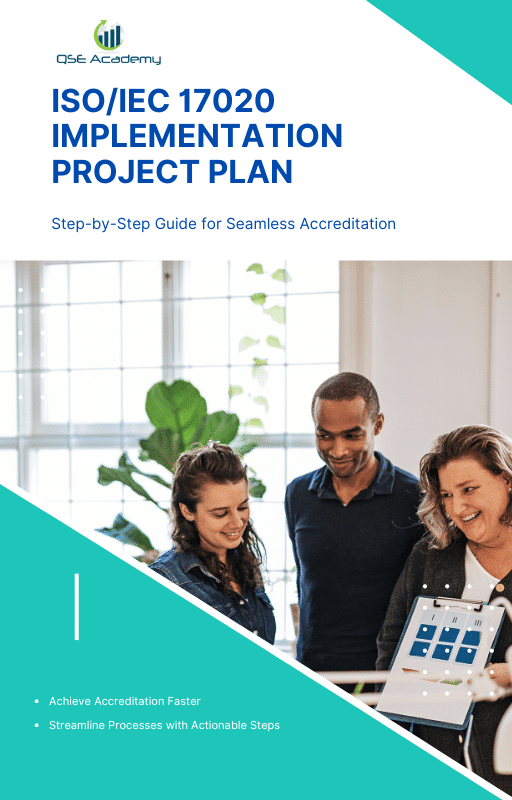ISO/IEC 17020 Documentation Toolkit: Everything You Need
Last Updated on October 22, 2025 by Hafsa J.
Why Your ISO/IEC 17020 Documentation Toolkit Matters
This is your foundation piece—the complete guide to building, structuring, and maintaining every document required for ISO/IEC 17020 compliance. Whether you’re setting up a new inspection body or refining an existing one, your documentation system defines how clearly, consistently, and credibly your organization operates.
In ISO/IEC 17020, documentation isn’t a formality—it’s evidence. It proves that your inspection process is impartial, technically competent, and performed under controlled conditions. Every manual, procedure, form, and record tells the story of how your system works and why clients and regulators can trust your results.
Over the years, I’ve helped inspection bodies of all sizes prepare for accreditation. The difference between those that pass smoothly and those that struggle often comes down to documentation: not just having it, but having it aligned, accessible, and auditable. One small inspection company I worked with had skilled inspectors and solid processes—but they failed their first assessment because their documents weren’t version-controlled. Six months later, with a structured documentation toolkit in place, they passed without a single nonconformity. That’s the power of organized information.
In this article, you’ll find a complete framework for your ISO/IEC 17020 documentation system—what documents you need, how to structure them, and how to manage them in a way that makes audits predictable instead of painful.
By the end, you’ll have a clear blueprint for a documentation system that not only satisfies accreditation requirements but supports efficiency, traceability, and long-term compliance.
ISO/IEC 17020 Documentation Structure Explained
Before you create or revise a single document, it’s important to understand how ISO/IEC 17020 expects your documentation system to fit together. Think of it as a pyramid—each level supports the next, with your Quality Manual at the top and detailed inspection records at the base. A well-structured system ensures that every procedure, form, and report aligns with the standard, remains traceable, and can be easily verified during audits.
Here’s how that structure typically looks in practice:
1. Level 1 — Quality Manual (The Framework)
Your Quality Manual defines the “what” and “why” of your system. It summarizes your organization’s structure, impartiality commitments, and reference to the ISO/IEC 17020 clauses your procedures address.
-
Keep it concise—no need to copy the entire standard.
-
Include your scope of inspection activities, management responsibilities, and system references.
-
Pro Tip: Treat the manual as a map. Every process and record should trace back to a section within it.
2. Level 2 — Procedures (The How)
Procedures describe how your inspection body carries out and controls each process.
They typically cover:
-
Document and record control
-
Competence and authorization
-
Inspection planning and execution
-
Handling complaints and appeals
-
Internal audits and management reviews
Each procedure should define the purpose, responsibility, method, and records generated.
Common Pitfall: Using generic templates that don’t reflect your actual workflow. Auditors can spot this immediately.
3. Level 3 — Work Instructions and Forms (The Tools)
Work instructions are task-specific and guide inspectors or staff on performing consistent activities—whether calibrating equipment or completing a site inspection.
Forms and templates ensure uniform data capture.
-
Example: “WI-07 Equipment Verification” and its form “FM-07 Verification Checklist.”
-
Keep formats simple but standardized—fields for date, inspector, revision, and approval matter as much as the content itself.
4. Level 4 — Records (The Proof)
Records are evidence that your system functions as documented. They show what was done, by whom, and when.
Examples include completed inspection checklists, calibration logs, training files, and management review minutes.
-
Records must be legible, retrievable, and protected from alteration.
-
Always reference your retention schedule so nothing gets deleted prematurely.
-
Pro Tip: Establish a Record Register listing each record type, owner, and retention period—your future self (and your assessor) will thank you.
5. Keep It Cohesive
Your documentation system should read as one integrated story—from policy to practice. Cross-referencing is key:
-
The Quality Manual points to your procedures.
-
Procedures reference relevant forms and records.
-
Records link back to the originating process.
This hierarchy doesn’t just satisfy Clause 8.3—it makes your management system logical, auditable, and easy for staff to follow.
Now that you understand how the documentation structure fits together, let’s explore the foundation of it all: the ISO/IEC 17020 Quality Manual—the document that defines your system and sets the tone for everything underneath it.
ISO/IEC 17020 Quality Manual — The Foundation of Your Documentation System
Your Quality Manual is the backbone of your ISO/IEC 17020 documentation. It explains how your inspection body operates, ensures impartiality, and connects every part of your management system into one coherent framework. Think of it as your system’s “master reference”—the document that guides assessors, clients, and your own team through how you maintain control and consistency.
1. What the Quality Manual Must Contain
ISO/IEC 17020 doesn’t prescribe a fixed format for your manual, but it does expect you to address key elements that define your inspection body’s competence and impartiality. Your manual should include:
-
Scope of inspection activities (what you inspect, for whom, and under what conditions).
-
Organizational structure and reporting lines, highlighting how impartiality is maintained.
-
Reference to all key procedures—from document control to complaints handling.
-
Description of your management system—how it aligns with ISO/IEC 17020 clauses.
-
Commitment statements on confidentiality, independence, and continual improvement.
Pro Tip: Use the manual to summarize, not restate, procedures. If a section needs more detail, link to the relevant controlled document or SOP.
2. How the Quality Manual Fits Into Your Documentation Hierarchy
Your manual sits at the top of your documentation pyramid:
-
It refers down to procedures and instructions.
-
It summarizes what your management system does, not how each step is performed.
-
It demonstrates top management commitment to impartiality and competence.
A well-written manual tells auditors that your system is both structured and mature—it shows clarity before they even open a single record.
3. Structuring Your Manual for Audit Readiness
Keep it simple and easy to navigate. A typical format includes:
-
Introduction and Scope
-
Normative References and Definitions
-
Organizational Structure and Roles
-
Management System Overview
-
Inspection Process Summary
-
Impartiality and Confidentiality Policy
-
Reference List of Procedures and Forms
Pro Tip: Include a Clause Cross-Reference Table linking each ISO/IEC 17020 clause to the section or procedure where it’s addressed. Assessors love this—it saves them time and shows you’ve designed your documentation intentionally.
4. Common Pitfalls to Avoid
-
Writing a manual that’s a copy-paste of the ISO standard.
-
Omitting clear references to key procedures.
-
Forgetting to update the manual when your organization structure or scope changes.
Pro Tip: Treat your Quality Manual as a live document—review it at least annually or whenever a major change occurs.
A strong Quality Manual sets the tone for your entire documentation system. It communicates professionalism, transparency, and control—before the assessor even starts the detailed review.
ISO/IEC 17020 Mandatory Procedures and Core Processes
Every accredited inspection body must demonstrate that its management system is not only documented but operationally controlled. ISO/IEC 17020 lays out several key areas where written procedures are mandatory—these aren’t optional paperwork exercises; they are the foundation of your compliance and evidence of consistent, impartial performance.
Let’s look at what those mandatory procedures are, how they fit into your system, and how to design them so they’re clear, practical, and audit-ready.
1. Document and Record Control Procedure (Clause 8.3 & 8.4)
This procedure ensures all documents are created, approved, distributed, and archived in a controlled manner.
It should define:
-
How new or revised documents are reviewed and approved.
-
How obsolete versions are removed from circulation.
-
How records are stored, protected, and retained.
Pro Tip: Add a simple flowchart showing how a document moves from draft → review → approval → release. Visual clarity often prevents user errors.
2. Inspection Process Control Procedure (Clause 7.1 – 7.4)
This is the heart of your system—it explains exactly how inspections are planned, conducted, reviewed, and reported.
Include:
-
How inspection requests are accepted and verified.
-
Steps for planning, performing, and reviewing inspections.
-
Criteria for decision-making and reporting.
-
Controls for subcontracted or field inspections.
Common Pitfall: Writing this generically. Tailor it to your inspection scope so that assessors can trace real processes through it.
3. Competence, Training, and Authorization Procedure (Clause 5.2)
Demonstrates that only qualified and authorized personnel perform inspections.
Document:
-
Competence criteria for each inspection type.
-
Training, assessment, and authorization steps.
-
Frequency of competence re-evaluation.
Pro Tip: Include a competence matrix—listing each inspector, authorized scope, and expiry date—for easy assessor verification.
4. Complaints and Appeals Procedure (Clause 7.5)
ISO/IEC 17020 requires impartial, transparent handling of external feedback.
Your procedure should outline:
-
How complaints are received, logged, and acknowledged.
-
Who investigates and how impartiality is preserved.
-
Response timelines and record-keeping rules.
Common Pitfall: Missing records of complaint closure. Every case should end with documented verification that corrective action was effective.
5. Impartiality and Risk-Management Procedure (Clause 4.1 & 4.2)
You must identify, analyze, and manage risks to impartiality.
Include:
-
How conflicts of interest are identified before and during inspections.
-
Periodic impartiality reviews.
-
Mitigation measures and escalation paths.
Pro Tip: Use a risk-register table linking each identified risk to its mitigation plan and review date.
6. Corrective and Preventive Actions Procedure (Clause 8.7 – 8.8)
Defines how your organization reacts to nonconformities and ensures they don’t recur.
The procedure should describe:
-
How nonconformities are reported.
-
Root-cause analysis and corrective-action planning.
-
Verification of action effectiveness.
Pro Tip: Align this with your internal audit results—each finding should trace to a closed corrective-action record.
7. Internal Audit and Management Review Procedures (Clause 8.5)
These show that you monitor your system’s health.
Include:
-
Audit planning, frequency, and reporting steps.
-
Management review inputs (audits, complaints, results, resources).
-
Outputs and action tracking from reviews.
Common Pitfall: Treating management review minutes as a formality. They should demonstrate real evaluation of performance and improvement.
When designed well, these procedures act as your system’s operating manual—they describe how you ensure consistency, impartiality, and compliance every day. Each one must be controlled, version-tracked, and referenced in your Quality Manual.
ISO/IEC 17020 Inspection Method Statements
Your inspection method statements are where your documented system meets day-to-day operations. They translate your policies and procedures into clear, step-by-step instructions that ensure every inspector performs work consistently, regardless of who’s assigned to the job.
When assessors review these documents, they want to see evidence that your methods are standardized, validated, and aligned with recognized technical criteria. A well-written method statement proves competence—it shows that inspections aren’t improvised but systematically controlled.
1. Purpose and Importance
Each method statement serves one goal: to guarantee that inspections produce reliable, repeatable results.
Under ISO/IEC 17020 Clause 7.1–7.4, you must demonstrate that all inspections follow defined methods appropriate to their scope.
Pro Tip: Keep your method statements practical. They should be detailed enough for a trained inspector to follow without asking questions, yet concise enough to update quickly when requirements change.
2. Core Elements of a Method Statement
Every method statement should contain:
-
Title and Identification: Include a unique code, revision number, and approval date.
-
Scope and Purpose: Describe what’s being inspected and why.
-
Reference Standards: List relevant codes, specifications, or client requirements.
-
Responsibilities: Identify who performs, reviews, and approves the inspection.
-
Equipment and Tools: Specify required instruments, calibration status, and acceptance criteria.
-
Methodology: Outline the inspection steps in order—preparation, execution, evaluation, and reporting.
-
Acceptance Criteria: Define measurable benchmarks for pass/fail or conformance.
-
Records and Reporting: Detail what forms, photos, or checklists must be completed.
Common Pitfall: Copying generic methods from industry guides without customizing them to your organization’s actual equipment or scope—this leads to nonconformities.
3. Validation and Control
Before use, every inspection method must be validated to confirm it’s technically sound.
-
Conduct trial inspections to verify repeatability.
-
Record results and obtain technical approval.
-
Assign a revision number once validated.
-
Store approved methods in your controlled document system.
Pro Tip: Validation records become audit evidence—keep them accessible alongside the current method statement.
4. Using Digital Method Templates
Many inspection bodies now create digital method templates that automatically link to relevant forms and records.
Advantages include:
-
Controlled updates through version tracking.
-
Consistent formatting across inspection types.
-
Easier linkage to electronic checklists and reports.
Example: A structural inspection template that lists each inspection step with dropdown fields for measurements, photos, and remarks—all automatically archived as a record.
5. Review and Revision Cycle
Regular reviews ensure your methods remain current with regulatory, technological, or client changes.
Set a review interval (often every 12 months or after significant project feedback).
During each review:
-
Check alignment with current standards.
-
Verify equipment references are up-to-date.
-
Log any changes in your document-revision register.
Common Pitfall: Updating inspection forms without revising the corresponding method statement—always synchronize the two.
When method statements are clear, validated, and regularly maintained, they become your operational playbook—showing assessors that your inspection results are not only competent but consistently controlled.
ISO/IEC 17020 Record-Keeping and Retention Rules
Once your inspections are underway, your next challenge is preserving the evidence. ISO/IEC 17020 treats records as proof that your system functions as documented. Every reading, checklist, calibration certificate, and review note forms a chain of traceability that links back to your procedures. Without that chain, even the best inspection process loses credibility.
1. What Record-Keeping Means Under ISO/IEC 17020
Clauses 7.3, 8.3, and 8.4 of the standard require inspection bodies to keep accurate, complete, and retrievable records of all inspection activities and management-system functions.
Your record system must show:
-
What was inspected,
-
Who performed the work,
-
When and how it was done, and
-
What the results were.
Pro Tip: Each record should have a unique ID, inspection reference, responsible person, and date—it’s the easiest way to satisfy traceability checks.
2. Categories of Records to Maintain
To stay compliant, your system should organize records into clear groups:
| Category | Examples of Records | Clause Reference |
|---|---|---|
| Inspection Records | Field notes, data sheets, photographs, test readings | 7.3 |
| Personnel Records | Training files, competence assessments, authorization letters | 5.2 |
| Equipment Records | Calibration certificates, maintenance logs | 6.2 |
| Management System Records | Internal audits, corrective actions, management reviews | 8.4–8.5 |
| Client & Contract Records | Agreements, complaints, appeals, confidentiality forms | 4.1–7.5 |
Common Pitfall: Mixing inspection reports with supporting inspection records. The report is an output; the underlying records are evidence.
3. Retention Periods
ISO/IEC 17020 doesn’t set fixed times—it requires you to define and document them.
Typical practice:
| Record Type | Minimum Retention Period | Rationale |
|---|---|---|
| Inspection data & reports | 5 years | Industry & accreditation norms |
| Equipment records | Life of equipment + 2 years | Demonstrates continuity of calibration |
| Personnel competence | Employment + 3 years | Shows ongoing competence history |
| Management-system records | 5 years | Evidence of continuous improvement |
| Complaints & appeals | 5 years after closure | Required under Clause 7.5 |
Pro Tip: If laws or client contracts require longer retention, apply the longer period—never less.
4. Storage, Access, and Protection
Your records must remain legible and secure for their entire retention life:
-
Use fire-safe cabinets for paper and encrypted drives or cloud storage for digital.
-
Restrict access by role—inspectors can view their own records; quality managers control full access.
-
Back up digital records routinely and test restorations twice a year.
Common Pitfall: Saving inspection evidence in personal drives or email chains—auditors view this as a loss of control.
5. Disposal and Archiving
When the retention period expires, dispose of records systematically:
-
Get management approval before destruction.
-
Use shredding or permanent deletion for sensitive data.
-
Maintain a Record-Disposal Log noting document type, date, and responsible person.
Archived records should remain retrievable within the retention period and clearly labeled as inactive.
Strong record-keeping transforms your inspection body’s data into defendable proof of competence and consistency. When assessors can trace every inspection result back to its origin, you demonstrate the reliability that ISO/IEC 17020 is built upon.
ISO/IEC 17020 Electronic Document-Control Systems
Once your documentation expands beyond a few binders and spreadsheets, control becomes the real challenge. ISO/IEC 17020 doesn’t require you to go digital—but electronic document-control systems (EDCS) have become the industry standard because they make compliance faster, cleaner, and easier to demonstrate.
A well-implemented EDCS turns document control from a clerical task into a living, automated process. It protects integrity, manages revisions, and provides instant access to approved information whenever auditors, inspectors, or management need it.
1. Why Electronic Control Matters
Clause 8.3 demands documented control, approval, and revision of all management-system documents. With paper or shared-drive setups, those controls often break down—people edit copies, forget to remove outdated files, or lose approval history.
An EDCS fixes that by automatically tracking:
-
Who created or edited a document.
-
When approvals occurred.
-
Which version is active and who has acknowledged it.
Pro Tip: During audits, being able to show a full digital audit trail within seconds builds instant confidence.
2. Core Features of a Compliant EDCS
To meet ISO/IEC 17020 expectations, your system should include:
-
Version & Revision Control: Automatic numbering and “superseded” labeling.
-
User Roles & Access Permissions: Only authorized users can edit or approve.
-
Electronic Signatures: Secure, timestamped approvals replacing manual sign-offs.
-
Audit Trails: Transparent history of every change.
-
Back-Up & Recovery: Scheduled backups, ideally with off-site redundancy.
-
Notification & Acknowledgment: Alerts when new versions are released.
-
Search & Retrieval: Quick access to current procedures, forms, and records.
Common Pitfall: Using generic cloud storage (like Google Drive or Dropbox) without permissions or revision controls—these don’t satisfy full traceability requirements.
3. Integration with Your Management System
Your EDCS shouldn’t work in isolation. Ideally, it connects to:
-
Training records so staff automatically confirm new procedure awareness.
-
Audit and corrective-action logs for cross-reference and traceability.
-
Risk and impartiality registers to maintain contextual links.
When integrated, your document system becomes the backbone of your ISO/IEC 17020 compliance—not just a filing cabinet.
4. Implementation Tips
-
Start by mapping your current manual process, then automate it step-by-step.
-
Use controlled templates for manuals, procedures, and forms before migration.
-
Pilot the system in one department first, gather feedback, and refine before full rollout.
-
Train every user—clarity beats complexity when adopting new tools.
Pro Tip: Build a short “EDCS User Procedure.” Auditors appreciate documented evidence that staff are trained to use the system correctly.
5. Continuous Maintenance
Once implemented:
-
Review user access quarterly.
-
Validate backups monthly.
-
Audit document-control functionality annually as part of your internal audit program.
Keeping the system healthy ensures your records remain accurate and retrievable long after accreditation.
Electronic control systems make ISO/IEC 17020 documentation management transparent, secure, and scalable. With the right setup, document control stops being an administrative burden and becomes a proactive part of your quality assurance process.
ISO/IEC 17020 Documentation Templates and Registers — Building Your Toolkit
At this point, you know what each document type does and how they fit together. The next step is assembling them into a structured, usable toolkit. Your ISO/IEC 17020 documentation toolkit isn’t just a folder full of files — it’s your organization’s operational map. Every template, register, and checklist should make compliance easier to manage and simpler to demonstrate during assessments.
1. Core Templates Every Inspection Body Needs
A consistent set of templates ensures that your team records and reports information the same way every time. Below are the key templates to include in your toolkit:
| Document Type | Example File Name | Purpose |
|---|---|---|
| Quality Manual | QM-01_QualityManual.docx | Defines your system structure and key policies |
| Document Control Procedure | QP-02_DocControl.docx | Describes document creation, approval, and revision |
| Inspection Planning Form | FM-05_InspectionPlan.xlsx | Details client, scope, and resources per inspection |
| Competence Matrix | REG-03_CompetenceRegister.xlsx | Tracks inspector qualifications and authorizations |
| Equipment Calibration Log | REG-05_EquipmentRegister.xlsx | Records calibration dates and results |
| Nonconformity Report | FM-09_NCReport.docx | Logs findings and corrective actions |
| Management Review Minutes | FM-11_MgmtReview.docx | Summarizes key decisions and improvement actions |
| Impartiality Risk Log | REG-07_RiskRegister.xlsx | Identifies and monitors risks to impartiality |
Pro Tip: Use consistent naming conventions — “DocumentType-Number_Title” — so anyone can locate files quickly, even under audit pressure.
2. Document and Record Registers
Registers act as your documentation index. They make version control, ownership, and status transparent across the organization.
Essential Registers to Maintain:
-
Master Document Register: Lists all controlled documents, current revision, approval date, and owner.
-
Record Retention Register: Defines how long each record type is kept and where it’s stored.
-
Training & Competence Register: Links employee roles to required competencies.
-
Corrective-Action Log: Tracks nonconformities, root causes, and closure status.
-
Equipment Register: Shows each instrument’s ID, calibration status, and due date.
Common Pitfall: Keeping these registers on individual computers instead of in your controlled system. Centralize them so everyone refers to one verified source.
3. Toolkit Design Tips
-
Modularize: Create separate folders for Manuals, Procedures, Forms, Records, and Registers.
-
Version Protect: Add headers or footers showing document ID, revision, date, and status (e.g., Controlled Copy – Rev. 2).
-
Audit Link: For each template, indicate which ISO/IEC 17020 clause it supports — this makes gap analysis straightforward.
-
Format Consistency: Use uniform fonts, logos, and headers to show professional control and unity.
Pro Tip: Always start with editable master templates stored under document control. Working copies for projects can be duplicated and referenced but never overwrite the controlled originals.
4. Digital vs. Manual Toolkit
If you’re using an electronic document-control system, upload all templates and registers as controlled templates — not just stored files. Configure access so only Quality or Admin roles can update them.
For manual systems, use printed master copies in a protected binder labeled “Controlled Templates – Master Set.”
5. Using the Toolkit in Daily Operations
-
During internal audits, use your toolkit as a quick-reference index — it speeds up evidence retrieval.
-
During training, use forms and registers as visual teaching tools.
-
For continual improvement, update templates based on audit findings and staff feedback.
A complete, well-organized toolkit turns documentation from a burden into a backbone. When every record, form, and procedure is easy to find, fill out, and verify, your inspection body demonstrates the hallmark of ISO/IEC 17020 compliance: consistency through control.
Maintaining and Improving Your ISO/IEC 17020 Documentation System
Once your documentation system is in place, the real test is how well you maintain it. ISO/IEC 17020 views documentation as a living system, not a one-time project. Procedures evolve, staff change, and inspection scopes expand. The challenge is keeping everything aligned—accurate, current, and fully controlled—so you stay ready for accreditation at any moment.
1. Establish a Review Cycle
Every controlled document should have a defined review frequency, typically once every 12 months or sooner if triggered by changes in operations, regulations, or feedback.
To maintain control:
-
Assign a Document Owner for each document.
-
Track review and approval dates in your Master Document Register.
-
Use your EDCS to send automated reminders for upcoming reviews.
Pro Tip: During management reviews, include a section on document status—this ensures updates aren’t overlooked.
2. Use Internal Audits as Documentation Health Checks
Internal audits aren’t just for operational performance—they’re your best tool for catching outdated or misaligned documentation.
During audits:
-
Verify that procedures match actual practice.
-
Check that staff use current versions.
-
Confirm that superseded documents are properly archived.
Common Pitfall: Treating document verification as a formality. Instead, make it part of every process audit to strengthen system accuracy.
3. Manage Change Effectively
A clear Document Change Procedure keeps your system consistent when updates occur.
Best practices:
-
Require documented justification for every change.
-
Log revisions with version numbers, change descriptions, and approvers.
-
Communicate changes promptly to all affected staff and require acknowledgment.
Pro Tip: Include a “Summary of Changes” section in each revised document—it saves time during audits and internal reviews.
4. Train and Engage Your Team
Even the best system fails if people don’t know how to use it. Make documentation awareness part of every onboarding and refresher training.
Train staff on:
-
How to locate and use current documents.
-
How to submit feedback or change requests.
-
Why documentation control protects both quality and impartiality.
Common Pitfall: Assuming technical staff will “figure it out.” Training should be formal, recorded, and reinforced regularly.
5. Link Documentation to Continual Improvement
Use your corrective-action, audit, and management-review outputs to drive document updates. For example:
-
A recurring audit finding may lead to revising a procedure.
-
A client complaint might trigger new inspection checklists.
-
A new standard revision could require structural changes in your manual.
Every improvement loop should close with updated documentation—this shows assessors that your system isn’t static, but evolving in line with real-world feedback.
6. Verify Control Before Every Assessment
Before external audits:
-
Run a quick document traceability check: pick any procedure and follow it down to forms, records, and evidence.
-
Confirm obsolete documents are archived and marked clearly.
-
Ensure staff acknowledgments of recent revisions are recorded.
Pro Tip: Keep a one-page “Document Control Readiness Checklist” handy—auditors appreciate fast, transparent responses.
By maintaining your documentation system proactively, you demonstrate exactly what ISO/IEC 17020 seeks: control, consistency, and continual improvement. When your documents tell the same story your staff and records do, assessors see confidence, not chaos.
ISO/IEC 17020 Documentation Compliance Checklist
Now that we’ve built your documentation system piece by piece, it’s time to test how well it holds up against ISO/IEC 17020 requirements. A checklist helps you verify readiness before any audit—internal or external—and ensures no gaps slip through the cracks. It also gives your team a clear, repeatable method to evaluate documentation control year after year.
1. Documentation Framework
| Requirement | Status (✔/✖) | Notes / Evidence |
|---|---|---|
| Quality Manual is current, approved, and aligned with scope | ||
| Documented procedures cover all ISO/IEC 17020 clauses | ||
| Work instructions and forms are standardized and version-controlled | ||
| Master Document Register maintained and up-to-date | ||
| Clause-to-document cross-reference matrix available |
Pro Tip: During internal audits, check your register first—it’s the quickest way to prove your entire system is under control.
2. Operational Control Documents
| Requirement | Status (✔/✖) | Notes / Evidence |
|---|---|---|
| Inspection Method Statements validated and approved | ||
| Competence Procedure defines authorization and evaluation | ||
| Complaints and Appeals Procedure implemented and records kept | ||
| Impartiality and risk assessments completed and reviewed annually | ||
| Corrective and Preventive Actions Procedure active and tracked |
Common Pitfall: Forgetting to close the loop on corrective actions—every action must have verification of effectiveness.
3. Records and Retention
| Requirement | Status (✔/✖) | Notes / Evidence |
|---|---|---|
| Record-keeping procedure defines retention times and responsibilities | ||
| Records are legible, traceable, and retrievable | ||
| Secure backup and restoration tested regularly | ||
| Disposal of obsolete records documented and approved | ||
| Confidentiality controls applied to client and inspection records |
Pro Tip: Keep your record-retention schedule pinned near your workstation—it saves confusion during audits.
4. Electronic Document-Control System
| Requirement | Status (✔/✖) | Notes / Evidence |
|---|---|---|
| EDCS includes version control, approval workflows, and audit trails | ||
| User access permissions reviewed quarterly | ||
| Backups performed and verified according to schedule | ||
| Notifications and acknowledgments tracked | ||
| Integration with training, audits, and corrective actions functional |
Common Pitfall: Not documenting your EDCS configuration or training—auditors may question control even if the system works perfectly.
5. Continual Improvement
| Requirement | Status (✔/✖) | Notes / Evidence |
|---|---|---|
| Internal audit reports available and actioned | ||
| Management review minutes include documentation performance | ||
| Document review log updated after every revision | ||
| Staff trained and aware of document-control responsibilities |
Pro Tip: Link your checklist to your management-review agenda—it turns audit readiness into a habit, not a scramble.
A completed checklist gives you instant visibility of your system’s health. It shows exactly where attention is needed and provides clear evidence of compliance.
FAQs — ISO/IEC 17020 Documentation Toolkit
Q1. What’s the minimum documentation required to comply with ISO/IEC 17020?
At a minimum, your inspection body needs:
-
A Quality Manual outlining the management system structure.
-
Documented procedures for all core processes (document control, competence, inspection, impartiality, complaints, corrective actions).
-
Records showing implementation of those procedures (training, audits, inspections, reviews).
Even a small inspection body must maintain these to prove consistency and impartiality.
Pro Tip: Start with the essentials and build gradually—over-documentation creates confusion and increases maintenance effort.
Q2. Can we reuse ISO 9001 or ISO 17025 templates for ISO/IEC 17020?
Yes, but adapt them carefully. ISO 17020 focuses on inspection activities, independence, and impartiality, which are not emphasized in ISO 9001 or ISO 17025.
Templates can provide structure, but the content must reflect your actual inspection processes, not testing or calibration operations.
Common Pitfall: Keeping references to “testing” or “measurement uncertainty” in reused documents—assessors see this as evidence of poor system understanding.
Q3. How detailed should our inspection procedures and method statements be?
They should be detailed enough that any qualified inspector can follow them without asking questions—but not so complex that they’re impractical to update.
A good method statement describes purpose, scope, criteria, equipment, steps, and acceptance limits.
Pro Tip: If your inspectors perform differently from what’s written, it’s a sign your method needs review—not that the inspectors are wrong.
Q4. How do we prove document control to an assessor?
During an audit, be ready to demonstrate:
-
How documents are created, reviewed, approved, and distributed.
-
Where current and obsolete versions are stored.
-
Who has access and how changes are communicated.
-
Evidence of acknowledgment or training after revisions.
A live demonstration—retrieving an approved procedure and showing its version history—proves control faster than any written explanation.
Q5. How often should we review and update documents?
Annually is standard, but reviews should also be triggered by:
-
Regulatory or standard updates.
-
Nonconformities or audit findings.
-
Process changes or client requirements.
Record every review, even if no revision occurs—it’s evidence that the document remains valid.
Q6. Can we keep all documentation electronic, or are hard copies still required?
Electronic control is fully acceptable and now preferred by most accreditation bodies, provided:
-
Access is restricted and traceable.
-
Backups and recovery are tested.
-
Documents are easily retrievable and protected from unauthorized edits.
Hard copies are optional—just ensure any printed versions are clearly marked as “uncontrolled copies.”
Q7. What’s the easiest way to start building a documentation system from scratch?
Begin with these steps:
-
Create a document register listing all documents and their owners.
-
Draft a short Quality Manual defining your structure and policies.
-
Write 5–7 essential procedures first (document control, inspection, competence, impartiality, complaints, corrective actions, internal audit).
-
Add records and forms as processes mature.
-
Implement version control and train staff.
Within weeks, you’ll have a functioning, auditable documentation system.
Building a Documentation System That Works for You
Your documentation system is more than an accreditation requirement—it’s the blueprint of your competence and credibility. Every policy, form, and record tells auditors and clients that your inspection body operates with structure, consistency, and integrity.
When implemented well, your ISO/IEC 17020 Documentation Toolkit becomes the foundation of daily control. It ensures everyone works from the same version of the truth—no missing procedures, no outdated forms, no uncertainty during audits. The result is a management system that supports your business instead of slowing it down.
Here’s what matters most as you finalize your system:
-
Keep documents simple, structured, and traceable.
-
Review them regularly and link changes to evidence of improvement.
-
Train your team so they understand—not just follow—your documentation process.
-
Treat your electronic or manual control system as a living part of your quality culture.
As one assessor once told me after reviewing a client’s system: “Good documentation doesn’t impress me because it’s thick—it impresses me because it’s clear.” That’s exactly what your toolkit should achieve—clarity, consistency, and confidence.
If you’re ready to bring structure to your ISO/IEC 17020 system, start with a comprehensive toolkit.
Download QSE Academy’s ISO/IEC 17020 Documentation Toolkit—complete with editable manuals, procedures, registers, and templates built to align perfectly with accreditation requirements.
Build it once, keep it controlled, and let your documentation system quietly prove your professionalism every single day.
I hold a Master’s degree in Quality Management, and I’ve built my career specializing in the ISO/IEC 17000 series standards, including ISO/IEC 17025, ISO 15189, ISO/IEC 17020, and ISO/IEC 17065. My background includes hands-on experience in accreditation preparation, documentation development, and internal auditing for laboratories and certification bodies. I’ve worked closely with teams in testing, calibration, inspection, and medical laboratories, helping them achieve and maintain compliance with international accreditation requirements. I’ve also received professional training in internal audits for ISO/IEC 17025 and ISO 15189, with practical involvement in managing nonconformities, improving quality systems, and aligning operations with standard requirements. At QSE Academy, I contribute technical content that turns complex accreditation standards into practical, step-by-step guidance for labs and assessors around the world. I’m passionate about supporting quality-driven organizations and making the path to accreditation clear, structured, and achievable.

